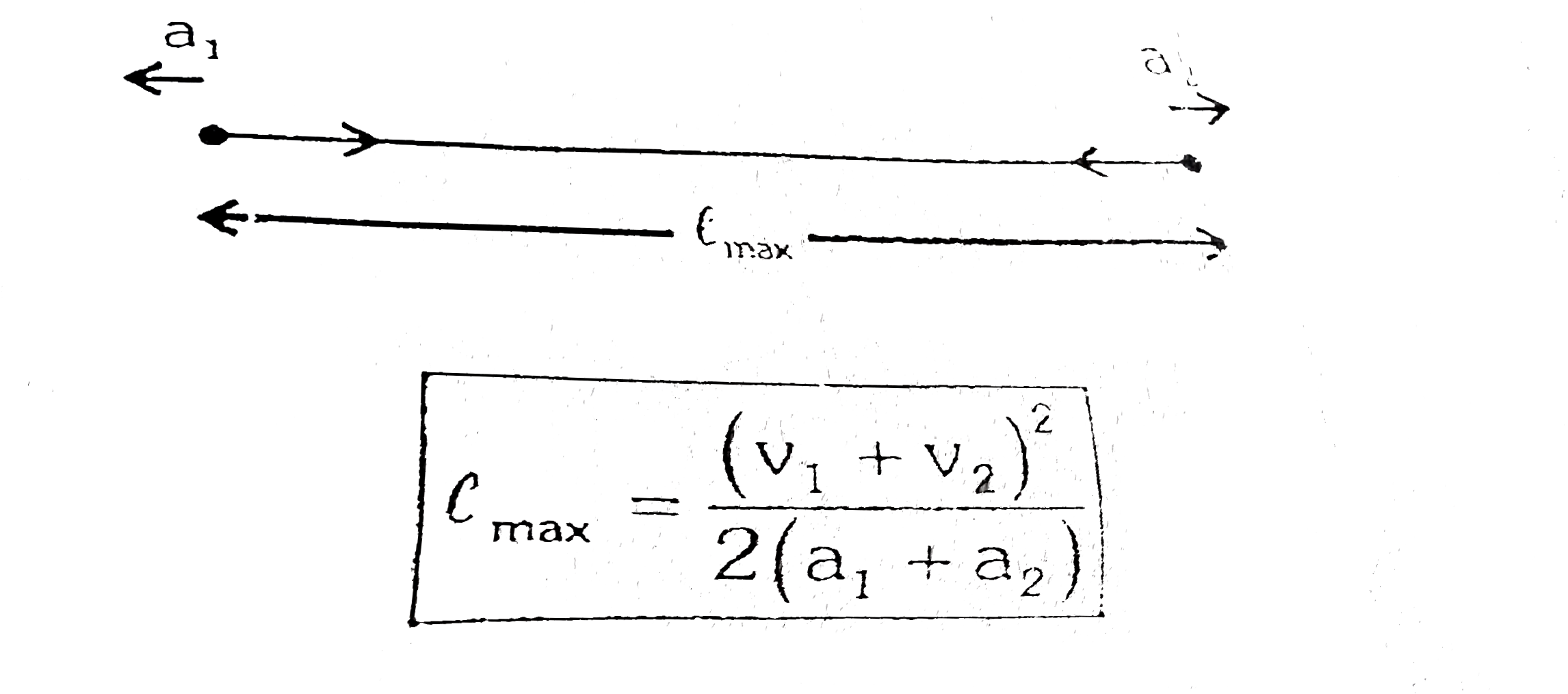Two bodies move in a straight line towards each other at initial velocities v1 and v2 and with constant acceleration a1 and a2 directed against the corresponding velocities at the initial instant. What must be the maximum initial separation between the bodies for which they meet during the motion ?
The correct Answer is:(v1+v2)22(a1+a2)
v12=v1−v2=v1−(−v2)=v1+v2

a12=−a1−a2=−(a1+a2).
Topper's Solved these Questions
- BOOK - ALLENCHAPTER - KINEMATICSEXERCISE - Exercise-05 [A]11videos
KINEMATICS
- BOOK - ALLENCHAPTER - KINEMATICSEXERCISE - Exercise-05[B]5videos
KINEMATICS
- BOOK - ALLENCHAPTER - KINEMATICSEXERCISE - EXERCISE-04[A]35videos
KINEMATICS
- BOOK - ALLENCHAPTER - ERROR AND MEASUREMENTEXERCISE - Part-2(Exercise-2)(B)22videos
ERROR AND MEASUREMENT
- BOOK - ALLENCHAPTER - KINEMATICS (MOTION ALONG A STRAIGHT LINE AND MOTION IN A PLANE)EXERCISE - BEGINNER S BOX-78videos
KINEMATICS (MOTION ALONG A STRAIGHT LINE AND MOTION IN A PLANE)
Similar Questions
Two trucks are moving in a straight line towards each other at initial velocities u1 and u2 and with constant retardations a1 and a2. If the initial separation between them is d, find the minimum value of d for no collision.
View SolutionDraw velocity time graph of a body which is moving with some initial velocity and a constant acceleration.
View Solution
Knowledge Check
- Question 1 - Select One or More
Two particles P and Q move in a straight line AB towards each other. P starts from A with velocity u1 and an acceleration a1 Q starts they pass each other at the midpoint of AB and arrive at the other ends of AB with equal velocities.
Athey meet at midpoint at time t=2(u2−u1)(a1−a2)BThe length of path specified i.e., AB is l=4(u2−u1)(a1u2−a2u1)(a1−a2)2CThey reach the other ends of AB with equal velocities if (u2+u1)(a1−a2)=8(a1u2−a2u1)DThey reach the other ends of AB with equal velocities if (u2−u1)(a1+a2)=8(a2u1−a1u2) - Question 2 - Select One or More
If two bodies are in motion with velocity →v1 and →v2:
A|vrel|=√v21+v22B|→–––(rel)|=v1±v2∣Cvre=0Dvrel>c (speed of light) - Question 3 - Select One
A particle moving on a straight line ultimately comes to rest ? What is the angle between its initial velocity and acceleration ?
AZeroBπ/4Cπ/2Dπ
A body travels along a straight line with uniform acceleration a1 for time t1 and with uniform acceleration a2 for time t2 for time t2. What is the average acceleration?
View SolutionA body with initial velocity 8 m/s moves along a straight line with constant acceleration and travels 640 m in 40 s. For the 40 s interval, find
the final velocityView SolutionA particle moves in a straight line as s=α(t−4)+β(t−4)2. Find the initial velocity and acceleration.
View SolutionThe distance x covered in time t by a body having initial velocity v0 and havig a constant acceleration a is given by x=v0t+(12)at2. This result follows from:-
View SolutionA body has an initial velocity of 3ms−1 and has an acceleration of 1ms−2 normal to the direction of the initial velocity. Then its velocity 4s after the start is.
View Solution

